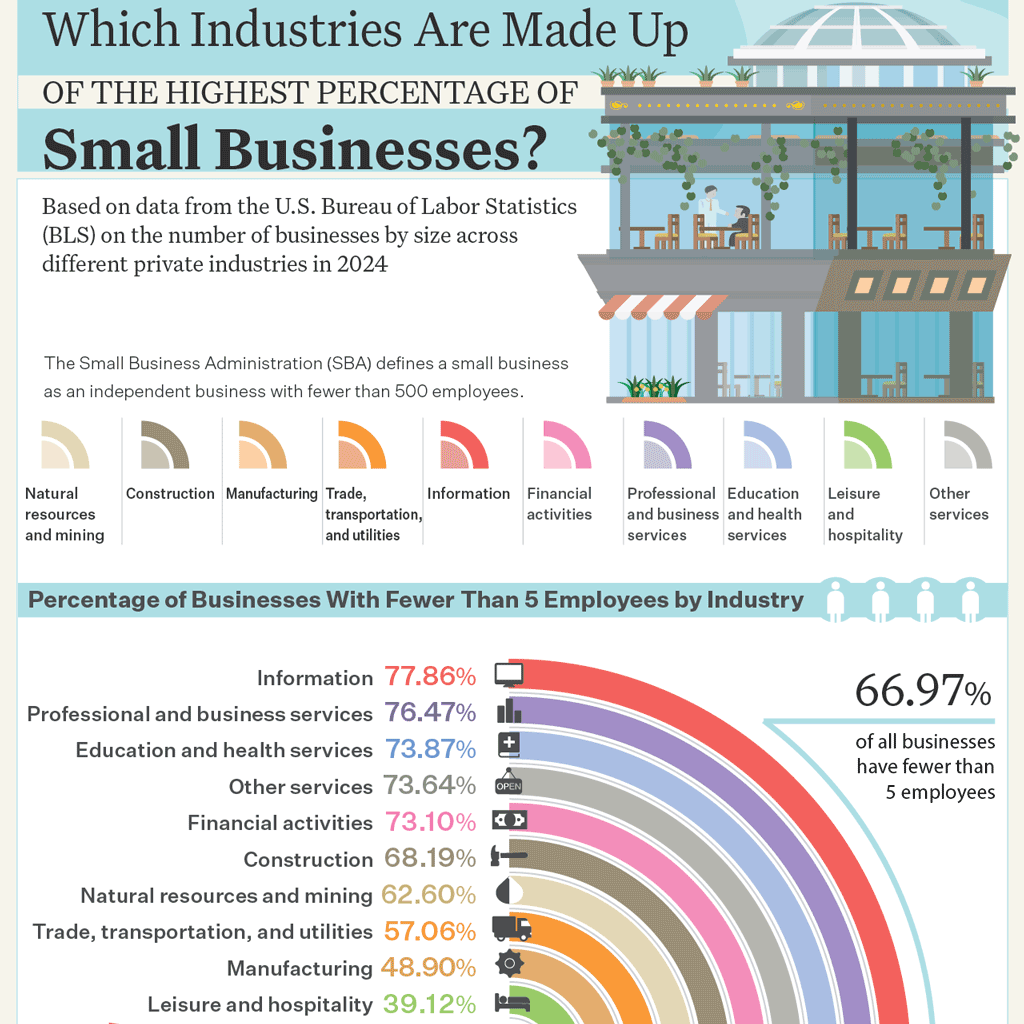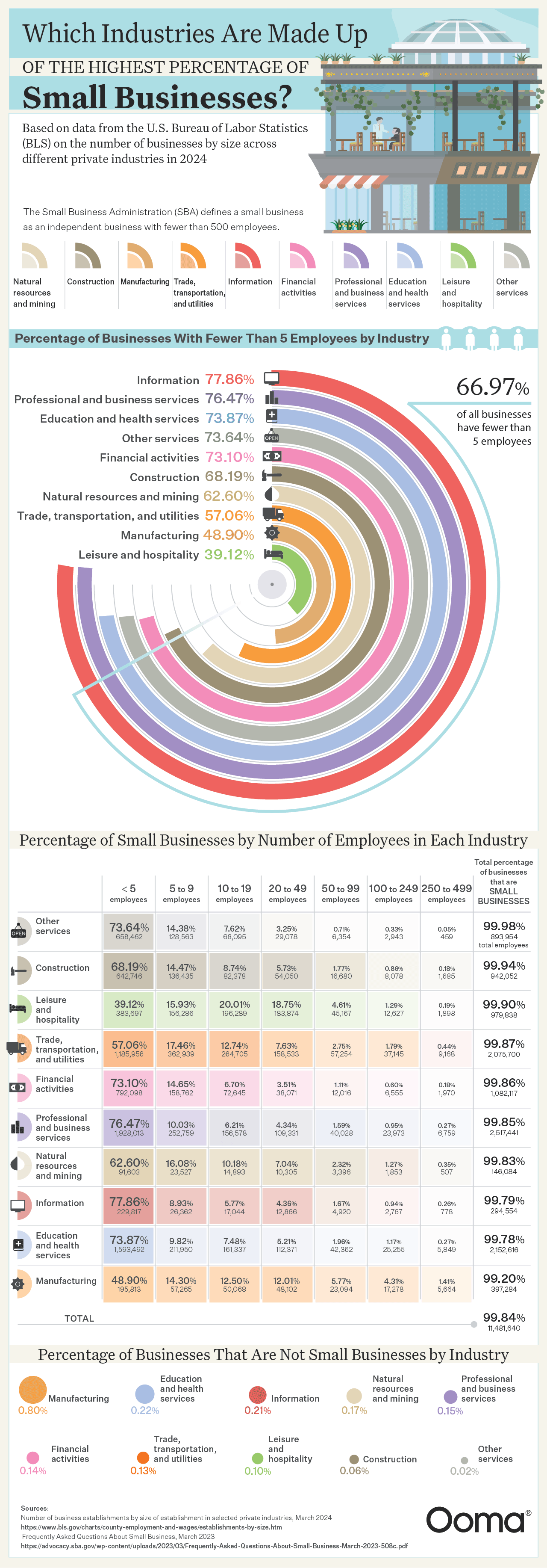Which industries have the highest percentage of small businesses?

Entire industries are built on the backs of small businesses. They are the heart of local economies and communities. According to a report from the Small Business Administration (SBA), small businesses account for 44 percent of economic activity in the United States. Beyond that, small businesses have been responsible for the majority of jobs created since the pandemic. Together these figures show why it’s so important to support small businesses to ensure future economic growth.
Ooma dug a little deeper. We took data from the U.S. Bureau of Labor Statistics and figured out which private industries have the highest percentages of small businesses. This data is broken down further by the number of employees at these small businesses.

According to the SBA, with some minor variation depending on the industry, a small business is defined as a privately owned company with fewer than 500 employees. In the United States alone, millions upon millions of businesses fall within this guideline, from agriculture to retail to manufacturing and everything in between.
The industry with the highest percentage of small businesses is construction, with 99.94 percent of construction companies being classified as a small business, and 68.19 percent having fewer than five employees. Many construction companies are family-owned businesses passed down generationally.
The leisure and hospitality industry is second in the rankings, with 99.9 percent of businesses classified as small businesses. Larger hotel chains and resorts are not privately owned, but that still leaves many smaller, independent hotels, motels, hostels and other accommodations.
At 99.87 percent, the trade and transportation industry rates third for the highest percentage of small businesses. More than 2 million small businesses fall within this category. The role of the public sector in transportation is quite significant, but freight railroad services and pipelines are almost entirely privately owned. To a lesser extent, boats, trucks and airport terminals also have their fair share of independent ownership.
The financial activities industry is fourth, consisting of 99.86 percent small businesses. Though large conglomerates may appear to dominate this industry completely, hundreds of thousands of lenders, brokers and other financial companies serve their local communities.
The professional and business services industry ranks fifth at 99.85 percent. This is where many of the nation’s service-providing businesses would fall. As in the construction industry, many service-providing businesses are family-owned businesses. Ownership of these companies often stays within a family for generations.
The importance of small businesses
If you frequent local boutiques or farmers’ markets, you may have seen slogans like “shop small” or “buy local”. These aren’t merely calls to action on behalf of the business owner: They draw attention to each patron’s role in building a vibrant community and maintaining the local and national economy. If all of the services or products in a specific industry can only be purchased from just one or two companies, that quickly becomes a monopoly. More businesses in an area means healthy competition and more diverse options for shoppers and consumers. These options are often better curated to reflect the preferences and needs of the people around them. Additionally, small businesses often source their materials and products from other small businesses in the area, which is better for the local economy and environmental sustainability.
Independent and local businesses also add a unique sense of identity to a town or city, fostering a sense of community and belonging. Big chain businesses may have perfected their branding but often lack a distinctive character, focusing instead on national or universal appeal. Too many big chains in a single area can create a rather generic atmosphere, where one town is indistinguishable from the next.
Owning a small business can be gratifying, but also extremely challenging, and it’s not a goal everyone is cut out to pursue. There is much to consider when starting a small business, such as the nature of the industry, branding, customer service, cash-flow management and more. However, running your own business enables a feeling of independence and fulfillment that may not be as prevalent in more corporate career paths. Even if you are not interested in owning a small business, though, you should consider supporting your local community by buying from independent businesses more frequently.
| Industry | Number of businesses with fewer than 5 employees | Percentage of businesses with fewer than 5 employees | Number of businesses with 5 to 9 employees | Percentage of businesses with 5 to 9 employees | Number of businesses with 10 to 19 employees | Percentage of businesses with 10 to 19 employees | Number of businesses with 20 to 49 employees | Percentage of businesses with 20 to 49 employees | Number of businesses with 50 to 99 employees | Percentage of businesses with 50 to 99 employees | Number of businesses with 100 to 249 employees | Percentage of businesses with 100 to 249 employees | Number of businesses with 250 to 499 employees | Percentage of businesses with 250 to 499 employees | Total number of small businesses | Total percentage of businesses that are small businesses | Number of businesses with 500 to 999 employees | Percent of businesses with 500 to 999 employees | Number of businesses with 1,000 or more employees | Percent of businesses with 1,000 or more employees | Total number of businesses | Total number of businesses that are not small businesses | Percentage of businesses that are not small businesses |
|---|---|---|---|---|---|---|---|---|---|---|---|---|---|---|---|---|---|---|---|---|---|---|---|
| Natural resources and mining | 91,603 | 62.60% | 23,527 | 16.08% | 14,893 | 10.18% | 10,305 | 7.04% | 3,396 | 2.32% | 1,853 | 1.27% | 507 | 0.35% | 146,084 | 99.83% | 182 | 0.12% | 69 | 0.05% | 146,335 | 251 | 0.17% |
| Construction | 642,746 | 68.19% | 136,435 | 14.47% | 82,378 | 8.74% | 54,050 | 5.73% | 16,680 | 1.77% | 8,078 | 0.86% | 1,685 | 0.18% | 942,052 | 99.94% | 440 | 0.05% | 123 | 0.01% | 942,615 | 563 | 0.06% |
| Manufacturing | 195,813 | 48.90% | 57,265 | 14.30% | 50,068 | 12.50% | 48,102 | 12.01% | 23,094 | 5.77% | 17,278 | 4.31% | 5,664 | 1.41% | 397,284 | 99.20% | 2,178 | 0.54% | 1,013 | 0.25% | 400,475 | 3191 | 0.80% |
| Trade, transportation, and utilities | 1,185,956 | 57.06% | 362,939 | 17.46% | 264,705 | 12.74% | 158,533 | 7.63% | 57,254 | 2.75% | 37,145 | 1.79% | 9,168 | 0.44% | 2,075,700 | 99.87% | 1,809 | 0.09% | 901 | 0.04% | 2,078,410 | 2710 | 0.13% |
| Information | 229,817 | 77.86% | 26,362 | 8.93% | 17,044 | 5.77% | 12,866 | 4.36% | 4,920 | 1.67% | 2,767 | 0.94% | 778 | 0.26% | 294,554 | 99.79% | 411 | 0.14% | 218 | 0.07% | 295,183 | 629 | 0.21% |
| Financial activities | 792,098 | 73.10% | 158,762 | 14.65% | 72,645 | 6.70% | 38,071 | 3.51% | 12,016 | 1.11% | 6,555 | 0.60% | 1,970 | 0.18% | 1,082,117 | 99.86% | 917 | 0.08% | 610 | 0.06% | 1,083,644 | 1527 | 0.14% |
| Professional and business services | 1,928,013 | 76.47% | 252,759 | 10.03% | 156,578 | 6.21% | 109,331 | 4.34% | 40,028 | 1.59% | 23,973 | 0.95% | 6,759 | 0.27% | 2,517,441 | 99.85% | 2,556 | 0.10% | 1,222 | 0.05% | 2,521,219 | 3778 | 0.15% |
| Education and health services | 1,593,492 | 73.87% | 211,950 | 9.82% | 161,337 | 7.48% | 112,371 | 5.21% | 42,362 | 1.96% | 25,255 | 1.17% | 5,849 | 0.27% | 2,152,616 | 99.78% | 2,405 | 0.11% | 2,239 | 0.10% | 2,157,260 | 4644 | 0.22% |
| Leisure and hospitality | 383,697 | 39.12% | 156,286 | 15.93% | 196,289 | 20.01% | 183,874 | 18.75% | 45,167 | 4.61% | 12,627 | 1.29% | 1,898 | 0.19% | 979,838 | 99.90% | 686 | 0.07% | 273 | 0.03% | 980,797 | 959 | 0.10% |
| Other services | 658,462 | 73.64% | 128,563 | 14.38% | 68,095 | 7.62% | 29,078 | 3.25% | 6,354 | 0.71% | 2,943 | 0.33% | 459 | 0.05% | 893,954 | 99.98% | 127 | 0.01% | 23 | 0.00% | 894,104 | 150 | 0.02% |
| TOTAL | 7,701,697 | 66.97% | 1,514,848 | 13.17% | 1,084,032 | 9.43% | 756,581 | 6.58% | 251,271 | 2.18% | 138,474 | 1.20% | 34,737 | 0.30% | 11,481,640 | 99.84% | 11,711 | 0.10% | 6,691 | 0.06% | 11,500,042 | 18,402 | 0.16% |
Sources:
Number of business establishments by size of establishment in selected private industries, March 2024
https://www.bls.gov/charts/county-employment-and-wages/establishments-by-size.htm
Frequently Asked Questions About Small Business, March 2023



